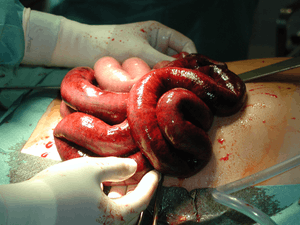Ileus
Ileus is a disruption of the normal propulsive ability of the intestine due to the malfunction of peristalsis.
| Ileus | |
|---|---|
 | |
| Gangrene of bowel causing gangrenous ileus | |
| Pronunciation |
|
| Specialty | General surgery |
Ileus originally referred to any lack of digestive propulsion, including bowel obstruction,[1][2] but current medical usage restricts its meaning only to those disruptions caused by the failure of the system's peristalsis and excludes failures due to mechanical obstruction, [3][4] with the exception of certain older terms such as "gallstone ileus" and "meconium ileus" which are still accepted as correct (though they are now technically misnomers) due to their persistence in usage. [5]
The word 'ileus' is from Greek εἰλεός eileós, "intestinal obstruction". The term 'subileus' refers to a partial obstruction.[6]
Signs and symptoms
Symptoms of ileus include, but are not limited to:
- moderate, diffuse abdominal discomfort
- constipation
- abdominal distension
- nausea/vomiting, especially after meals
- vomiting of bilious fluid
- lack of bowel movement and/or flatulence
- excessive belching
Cause
Decreased propulsive ability may be broadly classified as caused either by bowel obstruction or intestinal atony or paralysis. However, instances with symptoms and signs of a bowel obstruction occur, but with the absence of a mechanical obstruction, mainly in acute colonic pseudo-obstruction, Ogilvie's syndrome.
Bowel obstruction
A bowel obstruction is generally a mechanical obstruction of the gastrointestinal tract.
Intestinal paralysis
Paralysis of the intestine is often termed paralytic ileus, in which the intestinal paralysis need not be complete, but it must be sufficient to prohibit the passage of food through the intestine and lead to intestinal blockage. Paralytic ileus is a common side effect of some types of surgery, commonly called postsurgical ileus. It can also result from certain drugs and from various injuries and illnesses, such as acute pancreatitis. Paralytic ileus causes constipation and bloating. On listening to the abdomen with a stethoscope, no bowel sounds are heard because the bowel is inactive.
A temporary paralysis of a portion of the intestines occurs typically after abdominal surgery. Since the intestinal content of this portion is unable to move forward, food or drink should be avoided until peristaltic sound is heard, by auscultation (use of a stethoscope) of the area where this portion lies. Intestinal atony or paralysis may be caused by inhibitory neural reflexes, inflammation or other implication of neurohumoral peptides.
Risk factors
- gastrointestinal surgery or other GI procedures
- electrolyte imbalance (Namely hypokalemia and hypercalcemia)
- diabetic ketoacidosis (DKA),[7] and other causes of metabolic acidosis
- hypothyroidism
- diabetes
- medications (e.g. opioids or antimuscarinics)
- severe illness (Inflammation with peritonitis)
- spinal cord injury, those with injury above thoracic vertebrae 5 (T5) will have hypomotility problems within the bowel
- acute intermittent porphyria
Treatment
Traditionally, nothing by mouth was considered to be mandatory in all cases, but gentle feeding by enteral feeding tube may help to restore motility by triggering the gut's normal feedback signals, so this is the recommended management initially.[8] When the patient has severe, persistent signs that motility is completely disrupted, nasogastric suction and parenteral nutrition may be required until passage is restored. In such cases, continuing aggressive enteral feeding causes a risk of perforating the gut.
Several options are available in the case of paralytic ileus. Most treatment is supportive. If caused by medication, the offending agent is discontinued or reduced. Bowel movements may be stimulated by prescribing lactulose, erythromycin or, in severe cases that are thought to have a neurological component (such as Ogilvie's syndrome), neostigmine. There is also evidence from a systematic review of randomized controlled trials that chewing gum, as a form of 'sham feeding', may stimulate gastrointestinal motility in the post-operative period and reduce the duration of postoperative ileus.[9]
If possible the underlying cause is corrected (e.g. replace electrolytes).
Other animals
Ileus is a cause of colic in horses due to functional obstruction of the intestines. It most commonly seen in horses postoperatively, especially following colic surgery.[10] Horses experiencing ileus are at risk for gastric rupture due to rapid reflux build-up, and require intense medical management with frequent nasogastric intubation.[10] Ileus may increase adhesion formation, because intestinal segments have more prolonged contact and intestinal distention causes serosal injury and ischemia. It is usually treated with aggressive fluid support, prokinetics, and anti-inflammatories.[10]
References
- thefreedictionary.com > Ileus Citing:
- Dorland's Medical Dictionary for Health Consumers. 2007
- The American Heritage Medical Dictionary Copyright 2007
- Mosby's Medical Dictionary, 8th edition. 2009
- Saunders Comprehensive Veterinary Dictionary, 3 ed. 2007
- Merriam-Webster's medical dictionary. Retrieved Nov, 9, 2010
- Townsend CM, Beauchamp RD, Evers BM, Mattox KL (2004). "The biological basis of modern surgical practice". Sabiston Textbook of Surgery (17th ed.). Elsevier Saunders.
- Livingston EH, Passaro EP (January 1990). "Postoperative ileus". Dig. Dis. Sci. 35 (1): 121–32. doi:10.1007/bf01537233. PMID 2403907.
- Feldman M, Friedman LS, Brandt LJ, Sleisenger MH (2006). "Intestinal Obstruction and Ileus". Sleisenger & Fordtran's Gastrointestinal and Liver Disease (8th ed.). Elsevier Saunders.
- "Ileus Intestinal Obstruction". www.baermed.ch. Retrieved 2019-10-05.
- Kitabchi AE, Umpierrez GE, Murphy MB, et al. (January 2001). "Management of hyperglycemic crises in patients with diabetes". Diabetes Care. 24 (1): 131–53. doi:10.2337/diacare.24.1.131. PMID 11194218.
- McClave SA, Martindale RG, Vanek VW, et al. (2009). "Guidelines for the Provision and Assessment of Nutrition Support Therapy in the Adult Critically Ill Patient: Society of Critical Care Medicine (SCCM) and American Society for Parenteral and Enteral Nutrition (A.S.P.E.N.)". JPEN J Parenter Enteral Nutr. 33 (3): 277–316. doi:10.1177/0148607109335234. PMID 19398613.
- Fitzgerald JE, Ahmed I (December 2009). "Systematic review and meta-analysis of chewing-gum therapy in the reduction of postoperative paralytic ileus following gastrointestinal surgery". World J Surg. 33 (12): 2557–66. doi:10.1007/s00268-009-0104-5. PMID 19763686.
- Larson, Erica. "Equine Postoperative Ileus Insights". www.thehorse.com. The Horse. Retrieved 4 July 2014.
External links
| Classification | |
|---|---|
| External resources |